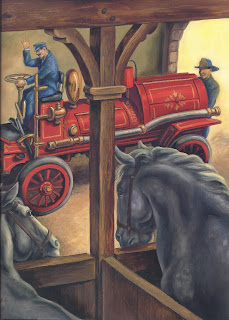Text copyright © 2005 by Jennifer Armstrong
Illustrations copyright © 2005 by Owen Smith
Magnus is one of a trio of gray stallions that pull the
heavy steam pumpers. These horses are “strong as oxen and fast as the
wind.” It is hard work but a good life. The horses do not want for food or shelter,
and they are treated kindly. After ten
years on the job for Magnus, progress arrives in the form of a motorized fire
engine, rendering the horse drawn engines obsolete. The motorized engines are
more cost efficient, so the horses are retired and put up for sale.
It is not
that simple for Magnus, being a fire horse is his life. He is conditioned to
spring into action once the fire bell rings.
Initially, after his retirement, Magnus is perplexed by the fact that he
is left behind. Then he begins leaping over the fence surrounding his pasture
and running to the fire when he hears the bell clang, even outracing the motorized engine. A taller fence is built, but Magnus simply busts it down. The captain
becomes increasingly irate with Magnus who he feels is becoming a nuisance.
One day the engine breaks down on the way to a fire.
The firemen and bystanders attempt to push the motorized engine, but it is
simply too ponderous. The fire is
burning out of control, and the Captain realizes that only Magnus is powerful
enough to haul the engine. Magnus is retrieved from in front of the fire, where
he stands, waiting. Even without the aide of
his two partners, Magnus attempts to tow the engine. It is a struggle but with
the encouragement of onlookers chanting “Pull Magnus! Pull!” and the firemen pushing from behind, he is able to
successfully haul the engine to the fire. It is to be his final job as a
fire horse. Magnus is then sent to live out the rest of his days comfortably in
an apple orchard, surrounded and loved by children.





No comments:
Post a Comment